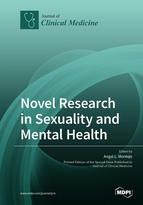Novel Research in Sexuality and Mental Health
A special issue of Journal of Clinical Medicine (ISSN 2077-0383). This special issue belongs to the section "Mental Health".
Deadline for manuscript submissions: closed (31 May 2019) | Viewed by 298000
Special Issue Editor
2. Institute of Biomedical Research of Salamanca (IBSAL), Paseo San Vicente SN, 37007 Salamanca, Spain
3. Nursing School, University of Salamanca, Av. Donates de Sangre SN, 37007 Salamanca, Spain
Interests: sexuality and mental health; psychotropic-related sexual dysfunction; sexual medicine
Special Issues, Collections and Topics in MDPI journals
Special Issue Information
Dear Colleagues,
Sexuality is considered as a great human value related to happiness and satisfaction, but unfortunately, when affecting mental disorders, they tend to be associated with second level human functions. Nevertheless, sexual dysfunction often accompanies psychiatric disorder, intensely influencing compliance, quality of life and human relationships. Sexuality could be influenced either by a mental disorder itself, difficulties to get and maintain couple relationships or by the use of psychotropic treatments. Treatment-related adverse events are unfortunately under-recognized by clinicians, scarcely spontaneously communicated by patients, and rarely investigated in clinical trials. The most frequent psychotropic compounds that could deteriorate sexuality and quality of life include antidepressants, antipsychotics and mood regulators. There are important differences between them related to some variations in mechanisms of action including serotonin, dopamine and prolactin levels. Little is known about the relevance of sexuality and its dysfunctions in chronic and frequent mental and neurological disorders, such as psychosis, mood disorders, anxiety, phobias, eating disorders, alcohol or drug dependencies, epilepsy and childhood pathology. Poor sexual life, low satisfaction and more frequent risky sex behavior than in the general population are associated with severe mental diseases. There is a need for increasing research in this field, including epidemiological, psychological, neurophysiological, neuroanatomical and genetic variables related to sexual life to get a better understanding of the implicated mechanisms. To increase the sensibility of clinicians, the identification and management of sexual disturbances after the onset of any mental disorder should be highlighted. This would avoid unnecessary suffering and deterioration of quality of life.
Prof. Angel L. Montejo
Guest Editor
Manuscript Submission Information
Manuscripts should be submitted online at www.mdpi.com by registering and logging in to this website. Once you are registered, click here to go to the submission form. Manuscripts can be submitted until the deadline. All submissions that pass pre-check are peer-reviewed. Accepted papers will be published continuously in the journal (as soon as accepted) and will be listed together on the special issue website. Research articles, review articles as well as short communications are invited. For planned papers, a title and short abstract (about 100 words) can be sent to the Editorial Office for announcement on this website.
Submitted manuscripts should not have been published previously, nor be under consideration for publication elsewhere (except conference proceedings papers). All manuscripts are thoroughly refereed through a single-blind peer-review process. A guide for authors and other relevant information for submission of manuscripts is available on the Instructions for Authors page. Journal of Clinical Medicine is an international peer-reviewed open access semimonthly journal published by MDPI.
Please visit the Instructions for Authors page before submitting a manuscript. The Article Processing Charge (APC) for publication in this open access journal is 2600 CHF (Swiss Francs). Submitted papers should be well formatted and use good English. Authors may use MDPI's English editing service prior to publication or during author revisions.
Keywords
- sexuality
- mental health
- mental disorder
- sexual dysfunction
- psychotropic (antidepressant, antipsychotic, antiepileptic)
- mechanism of action
- clinical management







